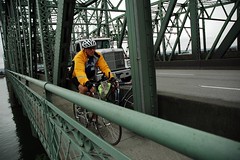Our old friend Mary Peters, the U.S. Department of Transportation Secretary who said bicycle paths aren’t transportation infrastructure, earned the rebuke of the League of American Bicyclists, than tried to make good with a verbose explanation, recently paid our region a visit.
She was here to trump the urgency of rebuilding the I-5 bridge over the Columbia River. Her visit was also timed with the announcement of new cost estimates for the project. Previously thought to cost somewhere around $6 billion, new estimates put the price tag at around $4 billion.
The project, known as the Columbia River Crossing (CRC), has raised my concerns in the past and I still feel queasy about the whole thing.
Now, with this strategic publicity blitz by the CRC folks and the cheerleading from the feds (they promise to pay as much as 80% of the project) I’m getting worried once again.
The snowball is growing and gaining speed.
Sure, the new bridge (if it ever gets built) will have nice bike facilities: a bicycle and pedestrian advisory committee full of smart people has been meeting for months (I can’t stomach showing up). But bike access is not what I’m worried about.
I’m frustrated that there is so little talk about the big picture. Why, once again, are we being seduced by a mega-project, with glowing promises about how a $4 billion bridge will bring “opportunity” and “prosperity”?
“If it actually contributes to an increase in vehicle miles traveled in our communities…it will be part of the problem, which is not acceptable.”
–Jill Fuglister, co-director of Coaltion for a Livable Future
I thought we’d learned from the past that increasing single occupancy vehicle capacity only increases single occupancy vehicle use…and isn’t that what we’re trying to avoid?
Where is the serious discuss of innovative demand management strategies, how the bridge alternatives stack up in reaching our greenhouse gas emission targets, how this might impact climate change concerns, the impacts on community livability, and other serious health and environmental issues?
A major part of Portland’s success has to do with our livability and our smart choices about transportation and our impact on the environment. This project should reflect those values.
Freight movement and motor vehicle capacity are no longer the sole avenue to economic prosperity. Economist Joe Cortright is at the forefront of this thinking. He recently published a paper titled, “Portland’s Green Dividend”. Cortright’s research concluded that our city’s land use and transportation policies, combined with our high rate of transit and bike use contribute $2.6 billion to our local economy every year.

concerns about the project
at a CRC Task Force meeting
back in February.
When the CRC Task Force held an important vote last February, dozens of concerned citizens packed ODOT’s downtown headquarters to express their disdain for this project.
Transportation expert and City Council hopeful Chris Smith said the CRC was “being seduced into building an icon” and he urged them to not focus on this one, five-mile corridor, but to spread the money and attention throughout the entire system.
The Coalition for a Livable Future — a non-profit made up of over 90 organizations that is “working for a just and sustainable region” — shares some of my concerns. Their co-director Jill Fuglister told me yesterday that,
“If the locally preferred alternative demonstrates that it actually contributes to an increase in vehicle miles traveled in our communities it will erase any gains from increases fuel efficiency. So, it will be part of the problem, which is not acceptable…
We are concerned that the proposals on the table aren’t considering these issues and are approaching this project in a business-as-usual manner, rather than thinking about this as the project where we demonstrate the 21st century approach to transportation planning that considers the relevant 21st century issues.”
I understand that congestion is a real problem, but when will we put our values into action and implement a different type of solution? Which mega-project will finally break away from the traditional highway-building mentality that has failed our country in so many ways for so many years?
If not here, where? If not now, when?
What are your thoughts on this project? (I would love to know that I’ve got it all wrong and that there’s really nothing to worry about.)


